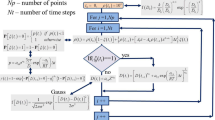Abstract
In this paper, measurements from experiments and results of a finite element analysis (FEA) are combined in order to compute accurate empirical models for the temperature distribution before a thermomechanically coupled forming process. To accomplish this, Design and Analysis of Computer Experiments (DACE) is used to separately compute models for the measurements and the functional output of the FEA. Based on a hierarchical approach, a combined model of the process is computed. In this combined modelling approach, the model for the FEA is corrected by taking into account the systematic deviations from the experimental measurements. The large number of observations based on the functional output hinders the direct computation of the DACE models due to the internal inversion of the correlation matrix. Thus, different techniques for identifying a relevant subset of the observations are proposed. The application of the resulting procedure is presented, and a statistical validation of the empirical models is performed.
Similar content being viewed by others
References
Bayarri, M.J., Berger, J.O., Cafeo, J.A., Garcia-Donato, G., Liu, F., Palomo, J., Parthasarathy, R.J., Paulo, R., Sacks, J., Walsh, D.: Computer model validation with functional output. Ann. Stat. 5, 1874–1906 (2007)
Broecker, C., Matzenmiller, A., Steinhoff, K.: Process simulation of stub shaft forging with local heating and cooling—an analysis with EFG. Comput. Methods Mater. Sci. 8, 144–153 (2008)
Chen, W., Baghdasaryan, L., Buranathiti, T., Cao, J.: Model validation via uncertainty propagation and data transformations. AIAA J. 42(7), 1406–1416 (2006)
Cressie, N.A.C.: Statistics for Spatial Data. Wiley, New York (1993). Revised edn
Dowding, K.J., Pilch, M., Hills, R.G.: Formulation of the thermal problem. Comput. Methods Appl. Mech. Eng. 197(29–32), 2385–2389 (2007)
Goldstein, M., Rougier, J.C.: Probabilistic formulations for transferring inferences from mathematical models to physical systems. SIAM J. Sci. Comput. 26, 467–487 (2004)
Haftka, R.T.: Combining global and local approximations. AIAA J. 29, 1523–1525 (1991)
Higdon, D., Kennedy, M.C., Cavendish, J.C., Cafeo, J.A., Ryne, R.D.: Combining field data and computer simulations for calibration and prediction. SIAM J. Sci. Comput. 26, 448–466 (2004)
Higdon, D., Nakhleh, C., Gattiker, J., Williams, B.: A Bayesian calibration approach to the thermal problem. Comput. Methods Appl. Mech. Eng. 197(29–32), 2431–2441 (2007)
Higdon, D., Gattiker, J., Williams, B., Rightley, M.: Computer model calibration using high-dimensional output. J. Am. Stat. Assoc. 103(482), 570–583 (2008)
Huang, D., Allen, T.T., Notz, W.I., Miller, R.A.: Sequential kriging optimization using multiple fidelity evaluations. Struct. Multidiscip. Optim. 32(5), 369–382 (2006a)
Huang, D., Allen, T.T., Notz, W.I., Zheng, N.: Global optimization of stochastic black-box systems via sequential kriging meta-models. J. Glob. Optim. 34(4), 441–466 (2006b)
Jin, R., Chen, W., Sudjianto, A.A.: An efficient algorithm for constructing optimal design of computer experiments. J. Stat. Plan. Inference 134, 268–287 (2005)
Jones, D.R., Schonlau, M., Welch, W.J.: Efficient global optimization of expensive black-box functions. J. Glob. Optim. 13, 455–492 (1998)
Keane, A.J.: Wing optimization using design of experiments, response surface, and data fusion methods. J. Aircr. 40(4), 741–750 (2003)
Kennedy, M.C., O’Hagan, A.: Predicting the output from a complex computer code when fast approximations are available. Biometrika 87(1), 1–13 (2000)
Kennedy, M.C., O’Hagan, A.: Bayesian calibration of computer models. J. R. Stat. Soc. Ser. B-Stat. Methodol. 63, 425–464 (2001)
Levy, S., Steinberg, D.M.: Computer experiments: A review. Adv. Stat. Anal. 94(4) (2010), this issue
Liu, F., Bayarri, M.J., Berger, J.O., Paulo, R., Sacks, J.: A Bayesian analysis of the thermal challenge problem. Comput. Methods Appl. Mech. Eng. 197(29–32), 2457–2466 (2007)
Lophaven, S.N., Nielsen, H.B., Sondergaard, J.: Aspects of the MATLAB toolbox DACE. Report IMM-REP-2002-13, Informatics and Mathematical Modelling, DTU (2002)
Maier, H.J., Tschumak, S., Weidig, U., Steinhoff, K.: Functional gradation of low alloy steel by differentially controlled phase transformation. Steel. Res. Int. 79(2), 33–38 (2008)
Matzenmiller, A., Broecker, C., Gerlach, S.: FE-analysis of simultaneous hot/cold forging. Steel. Res. Int. 80(2), 130–136 (2009)
Petelet, M., Iooss, B., Asserin, O., Loredo, A.: Latin hypercube sampling with inequality constraints. Adv. Stat. Anal. 94(4) (2010) this issue
Pistone, G., Vicario, G.: Comparing and generating latin hypercube designs in kriging models. Adv. Stat. Anal. 94(4) (2010) this issue
Qian, P.Z.G., Wu, C.F.J.: Bayesian hierarchical modeling for integrating low-accuracy and high-accuracy experiments. Technometrics 50(2), 192–204 (2008)
Qian, P.Z.G., Seepersad, C.C., Joseph, V.R., Allen, J.K., Wu, C.F.J.: Building surrogate models based on detailed and approximate simulations. J. Mech. Des. 128, 668–677 (2006)
Reese, C.S., Wilson, A.G., Hamada, M., Martz, H.F., Ryan, K.J.: Integrated analysis of computer and physical experiments. Technometrics 46, 153–164 (2004)
Rougier, J.: Efficient emulators for multivariate deterministic functions. J. Comput. Graph. Stat. 17(4), 827–843 (2008)
Sacks, J., Welch, W.J., Mitchell, T.J., Wynn, H.P.: Design and analysis of computer experiments. Stat. Sci. 4(4), 409–423 (1989)
Santner, T.J., Williams, B.J., Notz, W.I.: The Design and Analysis of Computer Experiments. Springer, New York (2003)
Watson, P.M., Gupta, K.C.: EM-ANN models for microstrip vias and interconnects in dataset circuits. IEEE Trans. Microw. Theory Tech. 44, 2495–2503 (1996)
Weidig, U., Huebner, K., Steinhoff, K.: Bulk steel products with functionally graded properties produced by differential thermo-mechanical processing. Steel Res. Int. 79(1), 59–65 (2008)
Wever, F., et al.: Atlas zur Wärmebehandlung der Stähle. Verlag Stahleisen M.B.H., Düsseldorf (1961)
Williams, B., Higdon, D., Gattiker, J., Moore, L., McKay, M., Keller-McNulty, S.: Combining experimental data and computer simulations, with an application to flyer plate experiments. Bayesian Anal. 1(4), 765–792 (2006)
Author information
Authors and Affiliations
Corresponding author
Additional information
This paper is based on investigations of the collaborative research centre SFB/TR TRR 30, which is kindly supported by the Deutsche Forschungsgemeinschaft (DFG).
Rights and permissions
About this article
Cite this article
Wagner, T., Bröcker, C., Saba, N. et al. Modelling of a thermomechanically coupled forming process based on functional outputs from a finite element analysis and from experimental measurements. AStA Adv Stat Anal 94, 389–404 (2010). https://doi.org/10.1007/s10182-010-0149-7
Received:
Accepted:
Published:
Issue Date:
DOI: https://doi.org/10.1007/s10182-010-0149-7




